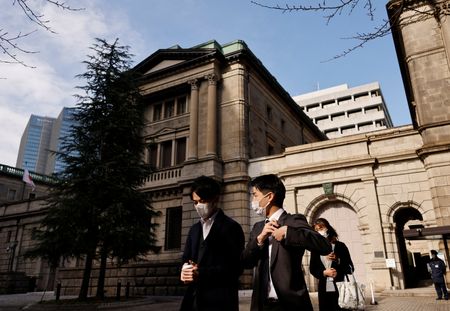A look at the day ahead in European and global markets from Wayne Cole.
It was a long wait, but the Bank of Japan finally decided to hurry up and do nothing – well, almost nothing.
The BOJ, it seems, will “patiently” continue with easing while “nimbly” responding to developments. Yield curve control remains as is, as do rates at -0.1%. So does the commitment to keeping them until 2% inflation is achieved in a stable manner.
Seemingly the only real change to guidance was to the sentence that it will not hesitate to take additional easing measures if necessary. The BOJ dropped the clause: “it also expects short- and long-term policy interest rates to remain at their present levels or lower”.
So, it is committed to its easy policy, but rates could go up? A tricky one to square.
In the same vein, the bank revised up its forecasts for CPI, while giving mixed signals on GDP. The key CPI ex-food measure is seen at 1.8% for fiscal 2023 and 2.0% for 2024, but crucially not above 2.0% as its remit requires.
While the BOJ did commit to a review of its interminable easing campaign, it proposed to finish it within one to one-and-a-half years. No hurry then.
For now, the market has taken the statement, and particularly the extended review time frame, as dovish, and pushed the dollar up 0.6% to 134.78 yen. Japanese 10-year bond yields are down almost 4 basis points at 0.425%, and Treasury yields dipped a fraction.
A lot of Western analysts assume YCC is done and now we’re just arguing over the burial date, whereas the Japanese tend to see everything over the long run: It’s only been a couple of decades, what’s the rush?
In any case, the next policy meeting is not until June 16, so the market has time to prepare.
The Nikkei newspaper partly stole the show by breaking the news while the BOJ was still meeting, although the initial reporting was a little confused on what actually the bank was doing and triggered some volatility.
Elsewhere, there was a mixed market reaction to results from retail behemoth Amazon which on the face of it beat forecasts with revenue growth of 9% to $127 billion. Its shares surged 10% at one stage, only to finish 2.1% lower after hours.
Maybe investors weren’t happy that revenue at its much-hyped AWS cloud unit grew by 16%, compared with 37% a year earlier, and the company in its conference call revealed April growth was about five percentage points lower than that.
Intel, on the other hand, talked up the prospect of improved margins in the second half, albeit from record lows, and was rewarded with a share rise of 5% after hours.
Looking ahead, a word of warning on the U.S. core PCE price index due later. Forecasts for the Fed’s favoured inflation indicator centre on a rise of 0.3% in March, but yesterday’s GDP data suggest a risk it could be as high as 0.5%.
Short-term yields have already spiked and market pricing for a Fed hike next week is back up to 85%, so a result like that would not be welcome.
Key developments that could influence markets on Friday:
– ECB chief Christine Lagarde holds a press conference following a Eurogroup meeting
– Euro zone finance ministers to discuss deposit guarantees in EU’s banking union
– Data on EU GDP for Q1 and German inflation for April
– U.S. personal income and consumption, PCE indexes, employment cost index and the Chicago PMI
(By Wayne Cole; Editing by Edmund Klamann)





